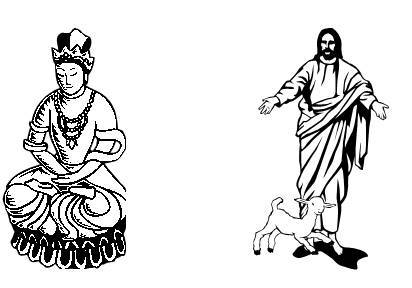Living
Buddha, Living Christ
~ a
thought-provoking comparison ~

On the surface, Buddhism and Christianity
are poles apart in their thinking. Often adherents of each religion tend to look down on the other while they
feel they are right and the other is wrong. Yet, surprisingly, interesting parallels can be seen between the
Buddha and Jesus Christ as the following table shows. By considering each other’s views, our perspective can
be not only enlarged, but also enriched. We can also grow in tolerance, humility and love, as well as awe at
the mysterious working of God in unexpected ways.
|
The Buddha
|
Jesus Christ
|
|
A historical person
(ca 400 BC – exact dates unknown)
|
A historical person
(ca 1 BC – 32 AD)
|
|
A transcendent
influence within us – “the Buddha of the ultimate reality, the one who transcends space,
time and all ideas.”
|
Personifying Divine
Love and nature, Jesus brought eternal life and immortality to life. As the Christ
principle, he too transcends time and space and through the
Holy Spirit lives in believers (see John 14:20, 23; 2 Cor 13:5; Gal 2:20; Col
1:27).
|
|
Born for a special
purpose. After his birth, among those who came to pay their respect was an old sage,
Asita, who predicted that Prince Sidhartha would become an important world
teacher.
|
Born to be the Messiah
(anointed) with a special mission. After his birth, wise men from the East came to
honour him as a king. The prophet Simeon in the Jerusalem temple declared under inspiration
that Jesus was the expected Messiah (Matt 2:1-11; Luke
2:25-34).
|
|
As a royal son, he
gave up his comforts after seeing the suffering of his subjects outside the royal palace.
After seeking and receiving enlightenment, he devoted the rest of his life in teaching and
serving others.
|
Jesus came to live and teach the way to salvation and
divinity through praying for and receiving from the Father Divine Love and nature.
He also served humanity by healing and casting out evil
spirits.
|
|
Buddha was human, but
through divine intervention (enlightenment) became an expression of the highest spirit of
humanity. His teachings and lifestyle example live on and are followed by many, transforming
many lives, making them loving, tolerant, and understanding.
|
Jesus’ life
personified the love of God. His teachings, if followed, are life-transforming. As the
fiirst divine son of God, he came to show the way for others to become divine children
of God (John 1:12-13; 3:15).
|
|
Buddha is regarded as a teacher pointing out a way or door to a life of
mindfulness, loving kindness, peace and joy. The practice of a loving life style
(mindfulness or Dharma)
will help others to minimize suffering in the present and the
future.
|
Jesus referred to
himself as the Truth, the Way and the Life (John 14:6). Through Jesus, the Kingdom of God,
representing God’s love and planted within us by the Holy Spirit, becomes a reality and
God’s witness on earth (Lk 17:20-21). Our mind are renewed, making us more kind and loving
(Rom 12:2; Gal. 5:22-25), which in turn will attract others to God's way of
love.
|
|
According to the Buddha, the Dharma or teachings of Buddhism are living and practiced rather then read
or listened to from sacred texts. One’s walking in mindfulness – being kind and loving to
others – is easily felt and perceived by others.
|
Christ’s teachings,
while preserved as sacred texts, are also living and dynamic. Believers are exhorted to walk
in the Spirit, not giving way to the negative human impulses. When they do that, the love of
God will be unmistakably perceived by others (Rom 5:5; Gal
5:16-25).
|
|
According to some, the
Buddha taught that each person has a seed of mindfulness within which he described as the
“womb” of Buddha.” In that sense, each person is a mother of the Buddha, for all are
pregnant with the potential for awakening. Practising mindfulness in daily lives will
eventually bring about revelation or enlightenment.
|
The Bible refers to
Christ (or the Holy Spirit / Divine Love) in our hearts giving us hope for eternal life (Rom
8:8-11). Another metaphor is that of Christ being formed in us (Gal 4:19). In that sense,
Mary was not the only one that gave birth to Jesus. We are also pregnant with Christ (Divine
Love) and thus being transformed into divine likeness and becoming at one with
God (Rom 8:29; Eph 4:11-13).
|
|
Buddhists see the
Buddha as a teacher and a brother, but not a god. They refer to “Perfection of Wisdom” as
the mother of all Buddhas.
|
While Christians see
Jesus as their Lord and Master, he is also their teacher, brother and friend (John
13:13-14; 15:14-15; 20:17; Heb 2:10-11; Rom 8:29). (Not all Christians, including
myself, view Jesus as God.) The metaphorical heavenly Jerusalem symbolising the
church is referred to as the mother (Gal 4:26). The Old Testament Scriptures also refer to a
female Wisdom figure whose existence predates all else (Prov
8:22-31).
|
|
Buddhists see every
human as a potential Buddha – enlightened, blessed, leader, teacher, one who knows the world
well (among other qualities).
|
Christians see every
human as a child of God by creation and a potential child of God, heir and co-heir of
Christ, immortal and glorified (Rom 8:10-17; John 1:12; Gal 3:29; 4:7; Eph.
3:6)
|
Reference: Thich Nhat Hanh, Living Buddha, Living
Christ (New York, Riverhead Books), 34-47.
|


 Facebook
Facebook Twitter
Twitter Digg
Digg Stumbleupon
Stumbleupon